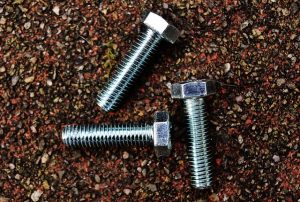
Along with screws, bolts are one of the most common types of fasteners. They are used specifically to create a bolted joint. A bolt can be driven into two or more workpieces — or components — to hold them together. The area where the workpieces are joined is known as a bolted joint. While bolts have a relatively simple construction, however, they feature several parts. Each of these parts is essential to the bolt’s functionality.
Head
The head is the uppermost part of a bolt. It serves as the gripping surface for tools. To tighten or loosen a bolt, a tool with the appropriate bit must grip the head. Most bolts have a wrench-type of head. In other words, a wrench bit must be placed around the bolt’s head. Nonetheless, some bolts use a screw-type head where the bit is placed in the center of the head. Whether wrench- or screw-type, all bolt heads provide a gripping surface so that the bolt can be tightened or loosened with a tool.
Some of the most common head styles for bolts include the following:
- Hex
- Slotted hex
- Socket cap
Shank
Below the head is the shank. The shank is the smooth part of a bolt that’s devoid of threading. It’s designed to prevent radial movements of the joined workpieces.
Without a shank, there’s a greater chance of the bolt loosening. Some workpieces produce vibrations, whereas others are exposed to vibrations in their surrounding environment. When the joined workpieces vibrate, the bolt may come loose if it doesn’t feature a shank. The lack of a shank means the bolt will consist entirely of threading from top to the bottom (with the exception of the head). Therefore, vibrations can push the bolt back out of the joined workpieces.
Threading
All bolts have threading. Threading is what allows a bolt to be driven into or out of workpieces. Most bolts don’t consist entirely of threading, however. They have a head, followed by a smooth shank and finally the threading. Depending on the type of bolt, the shank may consist of a larger surface area than the threading itself. Nonetheless, all bolts have threading.
A bolt’s threading works in conjunction with the internal threading of workpieces to join them. Bolts have external threading that’s located around the outside of their bottommost part. This external threading allows the bolt to be driven into or out of the workpieces’ internal threading.
